TUSCANY
Society

Society

Popular destinations ITALY
| Campania | Lombardy | Sardinia |
| Sicily | Tuscany | Umbria |
| Veneto |
Society
State structure
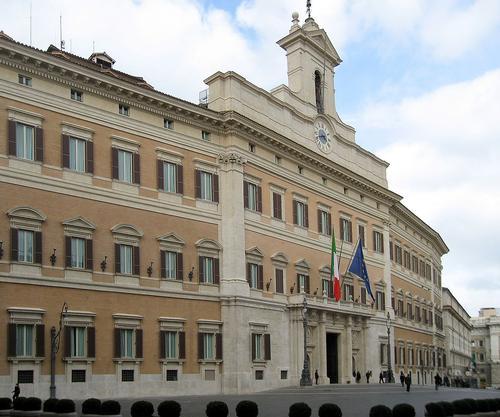 Italy's Parliament is located in the Palazzo MontecitorioPhoto: Manfred Heyde CC 3.0 Unported no changes made
Italy's Parliament is located in the Palazzo MontecitorioPhoto: Manfred Heyde CC 3.0 Unported no changes made
The Italian Parliament consists of a Chamber of Deputies (Camera dei Deputati) with 630 members and a Senate (Senato) with 315 members. In theory, Italians can go to the polls every five years to elect the representatives of the parliament and of the regional councils. In practice, early elections often take place in Italy.
The president has a seven-year term and is elected by a joint session of the two houses supplemented by three representatives from each regional council. The president has the right to dissolve the parliament and appoint the prime ministers. After his term of office, he automatically becomes a member of the Senate for life. The President of the Senate is a deputy to the President.
Cabinets last only about 11 months on average after World War II. For more about the political situation see the chapter about History.
Administrative division
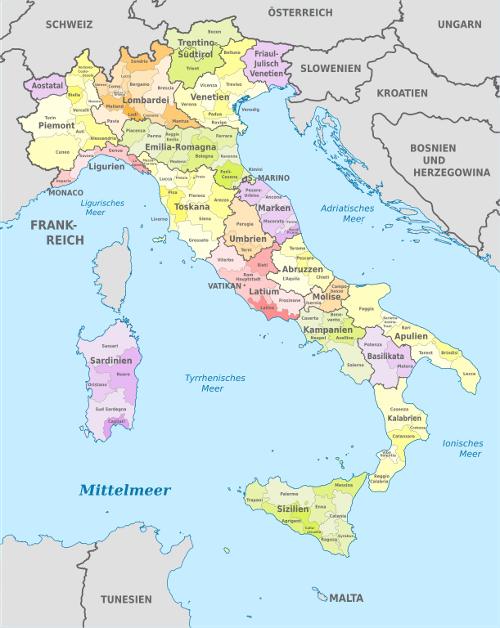 Regioni ItalyPhoto: TUBS CC 3.0 Unported no changes made
Regioni ItalyPhoto: TUBS CC 3.0 Unported no changes made
There are 20 regioni (regions), which are subdivided into 95 provinces and 8091 municipalities (comuni). These administrative units are governed by councils, which are elected every five years, and an executive body. The executive body is accountable to the board.
Five regions (Sicily, Sardinia, Aosta Valley, Trentino-Alto Adige and Friuli-Venezia Giulia) have a certain degree of autonomy (regioni a statuto Speciale), due to the fact that they are either islands or they border other countries .
The largest region is Sicily, the smallest Aosta Valley.
Below is an overview of the 20 regions with their respective capital:
- Abruzzo L'Aquila
- Basilicata Potenza
- Calabria Catanzaro
- Campania Naples
- Emilia-Romagna Bologna
- Friuli-Venezia Giulia Trieste
- Lazio Rome
- Liguria Genoa
- Lombardy Milan
- Le Marche Ancona
- Molise Campobasso
- Piedmont Turin
- Puglia Bari
- Sardinia Cagliari
- Sicily Palermo
- Trentino-Alto Adige Trento
- Tuscany Florence
- Umbria Perugia
- Aosta Valley Aosta
- Veneto Venice
Education
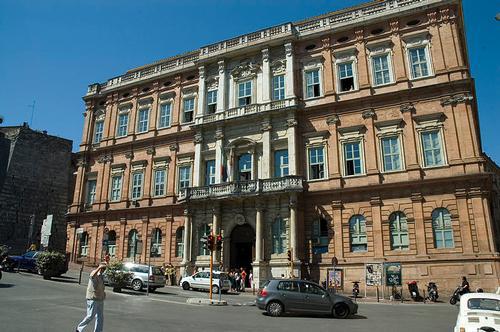 Italy Perugia UniversityPhoto: Francesco Gasparetti CC 2.0 Generic no changes made
Italy Perugia UniversityPhoto: Francesco Gasparetti CC 2.0 Generic no changes made
Pre-school education for 3 to 5 year olds is not compulsory. Education in public and private schools is generally paid for by the state. The public institutions are all state-owned.
In Italy, compulsory schooling is between ages six and fourteen and includes five years of primary education (scuola elementare) and three years of lower secondary education (scuola media). The government has made a proposal to increase compulsory education to ten years, from five to fifteen years.
Primary education is aimed at children aged six to eleven and consists of two cycles, one of two years and one of three years. The students automatically transfer from the first to the second cycle.
After five years of primary education, pupils take the exams for the diploma that gives access to lower secondary education.
Secondary education is for pupils aged eleven to fourteen and consists of three classes that form a complete study cycle.
Higher secondary education is open to young people aged 14 to 19. Compulsory education follows cycles of three, four or five years, after which one can continue studying at university or continue with a higher education or after which one can start working.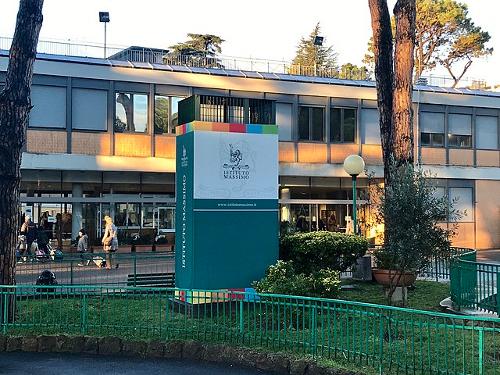 The Entrance to Liceo Massimo Classico e Scientifico InternazionaliPhoto: PaoloGeno CC 3.0 Unported no changes made
The Entrance to Liceo Massimo Classico e Scientifico InternazionaliPhoto: PaoloGeno CC 3.0 Unported no changes made
All schools after compulsory education fall under upper secondary education and can be divided into the following categories:
Classical and scientific courses (scuole di tipo classico): the "liceo classico" and the "liceo scientifico" prepare students for university and other forms of higher education.
Art courses: the "liceo artistico" and the "istituti d'arte", courses lasting respectively four and three years.
Technical training: there are different types of "istituti tecnici": agriculture, trade, business administration and foreign languages, tourism, surveying, industry, foreign trade, shipping; these courses last five years.
Vocational training: five years divided into a three-year qualification cycle and a two-year follow-up cycle, at the end of which one can transfer to higher education.
Higher university education is provided at public and private universities, technical colleges and other university institutions. University higher education comprises three cycles, which are respectively:
A "diploma universitario" after two or three years of study
A "diploma di laurea", after four or six years of study
A "diploma di specializzazione" after at least two years and a doctorate ("diploma di dottorato di ricerca") after at least three years.
There are three academic degrees in Italy, namely the "diploma", the "laurea" and the "dottorato di ricerca". The last two academic degrees entitle to the title of Dr. ("Dottore").
University education is provided exclusively in Italian. Non-university higher education can be followed by different types of higher education; this applies especially to art education, such as academies and conservatories.
In 1995-1996, there were 47 general universities, two universities of Italian studies for foreigners and three specialized universities (commerce; education; Catholicism); three polytechnic universities; seven specialized university institutes for architecture, bio-medicine, modern languages, marine studies, oriental studies, social issues and teacher training. The oldest university in Italy, and even in all of Europe, is that of Bologna (c. 1200). In the 13th century, universities were also founded in Genoa, Macerata, Naples, Padua and Perugia.
Mafia
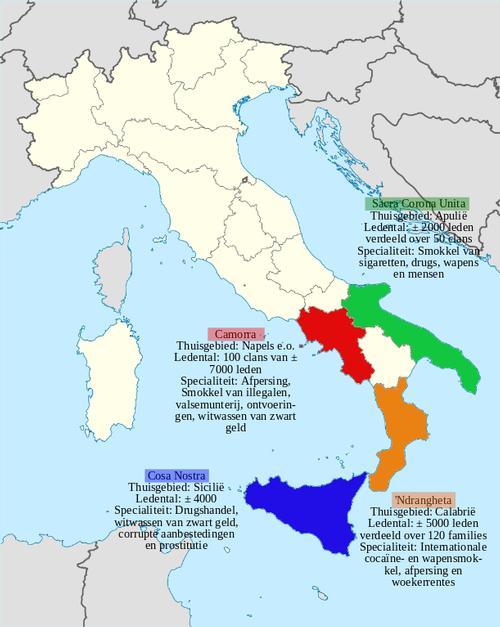 Home areas Italian mafiaPhoto: NordNordWest CC 3.0 Unported no changes made
Home areas Italian mafiaPhoto: NordNordWest CC 3.0 Unported no changes made
The mafia (Sicilian, from the Arabic afah = protection; Italian: mafia), is a collective name for secret, network-like organizations that were created in Western Sicily at the beginning of the 19th century and that operate in a violent manner. The members of those organizations are called mafiosi. The word mafioso was first used in 1863. The ambivalent relationships that the mafia has with representatives of the government (fighting them on the one hand, and cooperating with them on the other) sets them apart from other criminal organizations. In Naples the secret crime organization is called camorra, in Calabria 'ndrangheta and in Sicily Cosa Nostra. In the 20th century, around 1900, a mafia also emerged in the United States, also called Cosa Nostra, with many descendants of Sicilian immigrants.
The mafia has developed in Sicily mainly around Palermo, an area rich in large estates (latifundia). The mafiosi took the place of the landowners residing in Palermo and behaved like overseers and big tenants. They maintained intensive contacts with the landlords in the city. In return for securing their estates and later also for support in elections, the landlords offered the mafia protection against the government.
The mafia as one organization, with one central management, has never actually existed. The networks of local organizations, called cosche (plural of cosca, artichoke; the members of the local mafias are symbolized by the leaves of the artichoke), each controlled one particular territory and interacted with each other in all kinds of ways and through all kinds of organizations. They also fought each other to the death.
Both in Italy and in the United States, attempts by the government to combat the mafia were initially unsuccessful. Over the years, a series of anti-mafia laws came into force in Italy, which had little effect due to the lack of willingness by the local authorities to cooperate . Subsequently, a permanent parliamentary committee was set up by the government, which was to supervise compliance with these laws. After the murder of General Dalla Chiesa, prefect of Palermo, in 1982, a High Commissioner was appointed to coordinate the fight against the mafia. However, the first successes were not achieved until 1986 with the arrest in the United States of Tommaso Buscetta, the main “boss” of the Sicilian mafia. Hundreds of arrests were then made, followed by mass trials, including in Palermo. However, many convicts were soon released, probably because of the mafia's links with high political and judicial authorities. The murders of Mafia fighters and judges Giovanni Falcone and his successor Paolo Borsellino in 1992 gave new impetus to the fight against the mafia. In total, eleven mafia judges have been murdered so far.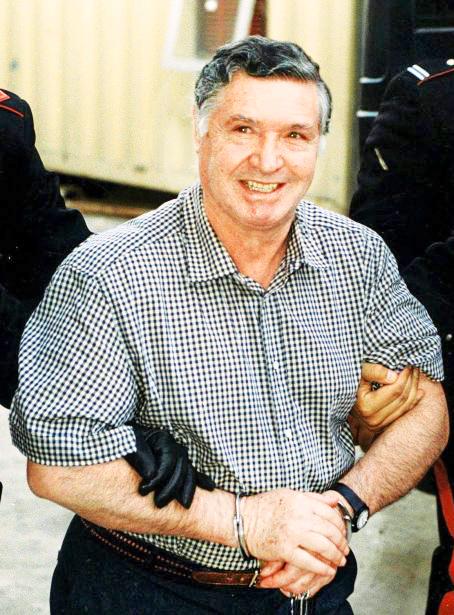 Totò Riina, big man of the Cosa Nostra, arrestedPhoto: Shirto CC 4.0 International co changes made
Totò Riina, big man of the Cosa Nostra, arrestedPhoto: Shirto CC 4.0 International co changes made
Thanks to the cooperation of many Mafia members (pentiti = repentants) who received freedom from punishment and protection in exchange for their statements, the leaders of the organization could also be arrested, such as the big boss in Sicily, Salvatore (Totò) Riina and the The Mafia's second man, Nitto Santapaolo. Riina was sentenced to life in March 1995. At the end of 1992, there were already more than four hundred of these repentants. The efforts of the Milan prosecutor led by the prosecutor Antonio di Pietro revealed the links between organized crime, politics and business. All this dealt heavy blows to the mafia, but it in no way meant that the organization had been wiped out. Even re-elected President Silvio Berlusconi in 2001 is suspected of having close links with organized crime. From 1973, for example, a certain Vittorio Mangano worked on one of Berlusconi's estates, who had strong links with the Sicilian mafia.
The mafia bosses now rule in silence. Drug trafficking and extortion are still the order of the day. The highest boss of the Cosa Nostra at the moment is Matteo Messina Denaro (1962), a fugitive since 1993, who succeeds Bernardo Provenzano (1933), who was arrested in April 2006.
'Ndrangheta
The 'Ndrangheta, a mafia organization in mainland Italy, was founded around 1860 in mountainous Calabria, in the south of Italy. The 'Ndrangheta, with a different structure from the Cosa Nostra, now has branches all over the world, and since the 1990s has surpassed Cosa Nostra as the most powerful crime organization in the world. In January 2021 a mega-trial started against at least 350 members of the 'Ndrangheta, including one capo, Luigi Mancuso, also called 'The Uncle', 'The Wolf ' or 'The Fat Man'.
Typcal Tuscany
Chianti
The most produced (approx. 700 vineyards) wine in Italy is the world-famous Tuscan Chianti. Chianti is produced in the area between Florence, Siena, San Gimignano and Arezzo. The smaller region Il Chianti, named after the wine, is the area where the ruby red "Chianti Classico" comes from. Only the wine produced in this area may be called "Vino Chianti Classico Gallo Nero". Approximately one million hectolitres of Chianti are produced annually, which is 73% of the total production of quality wines.
Chianti was already produced in the Middle Ages (ca. 1398), but the current Chianti was "invented" in the 19th century by baron and statesman Bettino Ricasoli, who, after long experimentation, found the ideal mix of different grape varieties. The ideal composition of Chianti consists of at least 75% Sangiovese, complemented by Canaiolo Nero (5-10%) and the white grape varieties Malvasia del Chianti and Trebbiano Toscano (together about 25%). From the 1970s onwards, there has been much experimentation with other grape varieties, particularly the cabernet grape.
The wine region where the Chianti is produced is quite large, as a result of which the quality of the Chianti wines can differ considerably. Wines with DOCG (Denominazione di Origine Controlata e Garantita), Classico Gallo Nero and Chianti Putto guarantee at least a reasonable quality. The Chianti Classico must have a minimum alcohol content of 12%, all other Chiantis minimum 11.5%. Since 1924 the winegrowers of the "Consorzio del Vino Chianti Classico" have been putting a neck label on their bottles depicting a "gallo nero", a black rooster, the symbol of Chianti Classico. The six other wine-growing regions use a "putto" as a distinguishing mark.
Typische wijndorpen zijn o.a. San Casciano in Val di Pesa, Sant’Andrea in Percussina, Tavernelle Val di Pesa, Barberino Val d’Elsa, Castellina in Chianti, Radda in Chianti, Gaiole in Chianti, Volpaia, Panzano, Greve en Montefioralle.
Besides the Chianti classico there are other Chianti types:
Chianti di Colli Pisane : hills around Pisa
Chianti Montalbano: west of Florence, partly from the Carmignano area.
Chianti Montespertoli: south of Empoli and southwest of Florence
Chianti Rufina: east of Florence
Chianti di Colli Fiorentini: Florence area
Chianti di Colli Senesi: hills around Siena
Chianti di Colli Arantini: hills around Arezzo.
The main competitors of the Chianti wines are the Brunello di Montalcino, the Sant'Antimo, the Vino Nobile di Montepulciano, the Sassiciai and the Carmignano. The most famous white wine is the Vernaccia di San Gimignano.
Siena Palio
The city of Siena is built on three hills in the shape of a Greek 'Y'. The three districts built on the hills converge on the shell-shaped Piazza del Campo. The three districts or 'terzi' of Siena, Terzo di Città, Terzo di Camollia and Terzo di San Martino, consist of 17 quarters or 'contrade'.
The Palio festival starts as early as 20 days before the race, when it is decided which quarters will be allowed to participate in the race. First, the seven districts that were not allowed to participate in the previous Palio are admitted. Then fate decides which three districts will be allowed to enter the race. Destiny also decides, after the selection races, which horse will be assigned to which district. The riders are professional riders from outside the city.
On the afternoon before the race, the "passeggiata storica" (historic procession) takes place after the horses are blessed in the parish church. On 2 July and 16 August, the Palio delle Contrade is held in the square. The race is held on unsaddled horses for a banner bearing the image of Mary, the city saint. The race lasts three laps and in time about one minute. The first horse to cross the finish line wins, regardless of whether the rider ('fantino') is still on it.
The Palio is first mentioned in 1283, and was first held in its current form in 1633. In the 18th century the edition of 16 August was held for the first time.
The edition of 2 July 2007 was won by the Contrada dell'Oca district with the rider Giovanni Atzeni and the horse Tittìa Fedora Suara. The edition of 16 August 2007 was won by the Contrada del Leocorno district with the rider Jonatan Bartoletti and the horse Scompiglio con Brento.
| district | symbol | virtue |
| Aquila | eagle | belligerence |
| Bruco | caterpillar | dexterity |
| Chiocciola | snail | prudence |
| Civetta | owl | discernment |
| Drago | dragon | passion |
| Giraffa | giraffe | elegance |
| Istrice | hedgehock | sharpness |
| Leocorno | unicorn | wisdom |
| Lupa | wolf | loyalty |
| Nicchio | shell | discretion |
| Oca | goose | perspicacity |
| Onda | wave (dolphin) | happiness |
| Pantera | panther | boldness |
| Selva | forest (rhino) | strength |
| Tartuca | tortoise | determination |
| Torre | tower (elephant) | resistance |
| Valdimontone | ram | perseverance |
Leonardo da Vinci (1452-1519)
Leonardo da Vinci was born in Vinci, about 60 km west of Florence. Leonardo's career began in Florence, where he became a pupil of the sculptor Andrea del Verrocchio. In 1472 he became a master painter and ten years later he left the Tuscan capital and settled at the court of the Sforzas in Milan. In 1494, the French attacked Milan and he returned to Florence, where he painted his most famous work, the Mona Lisa.
In 1506, he returned to Milan and entered the service of the French king. From this period onwards, he devoted himself mainly to science. In 1513, he went to live in Rome and in 1517 he died in a castle in Cloux.
Galileo Galilei (1564-1642)
Galileo Galilei was born in Pisa and graduated as a doctor. His real interest was in mathematics, physics and astronomy. In 1589 he became professor of mathematics at the university in Pisa. He taught there for three years and in the meantime wrote a book about his theories on falling bodies. In contrast to the Greek philosopher Aristotle, Galileo claimed that bodies of the same material fall at the same speed regardless of their weight.
Galileo's real fame came when he confirmed what Copernicus had always said: the planets, including the earth, revolve around the sun and not the other way around as the Catholic Church claimed. As late as 1615, the Church forbade the teaching of Copernicus, yet in 1624 Pope Urban VIII allowed Galilei to publish a book explaining Copernicus' theory alongside that of Aristotle.
In 1632 Galilei published the book "Dialogo sopra i due massimi sistemi di mondo" (Dialogue on the two most important systems of the world), in which he clearly chose the doctrine of Copernicus. The Church, of course, did not accept this and he was taken to the ecclesiastical court and his book was placed on the 'Index', a list of banned books.
Only in the 21st century did the Vatican officially declare that the ecclesiastical court had made a mistake.
Niccolo Machiavelli (1469-1527)
Niccolò Machiavelli (Florence, 3 May 1469 - Florence, 21 June 1527) was an Italian politician and philosopher. On 28 May 1498, he became head of the Second Chancellery of the Grand Council of Florence, his main public office, from which he was removed at the end of 1512.
The following year, in 1513, he wrote Il Principe (The Prince), a book that is still read today. The main part of the book is characterised by utilitarian thinking: the end justifies the means. More extensive and perhaps more important than Il Principe are the Discorsi, or Discourses on the First Ten Books of Titus Livio.
According to Machiavelli, Italy experienced a disastrous time in those years, especially since the Italian Wars began in 1494, when Charles VIII crossed the Alps with French armies and the Italian states were powerless. The Italian Wars would last until 1559. In the history of ancient Rome, as described by Titus Livius and others, Machiavelli saw a founding counter-example.
Throughout his life, he tried to encourage Italy to free itself from the foreign rulers who were in charge there. He had the knowledge, but not the power. Those who had the power did not want to use his knowledge according to his insights.
As head of the Second Chancellery, he was responsible for issues relating to Florence's territory and foreign policy. Florence had been a republic for four years after the citizens deposed Pierro de' Medici. Five days before Machiavelli took office in May 1498, he witnessed the execution of the founder of the republic, Girolamo Savonarola, who was hanged and burned alive in Piazza della Signoria after the end of the First Italian War.
Although he was known in Florence for his lack of respect for everything and everyone, he was very serious as a politician. He was convinced that only a strong state could protect its citizens, especially from the warring factions of the time: Venice, the King of France, the Pope, and Duke Valentino. Although his city was rich, its citizens did not want to invest in an army of their own. The city tried to remain neutral in most conflicts, but if it remained so for too long, it often had to redeem its freedom with gold ducats. Machiavelli understood that this situation could not last; the money of the rich but defenceless nation would not be enough to save it. He wanted a militia, not mercenaries, made up of citizens who would be loyal to the Republic.
Through a roundabout route, he obtained permission from the Grand Council to recruit the necessary peasants, although the nobility opposed this decision. He persevered and on 15 February 1506 he had 400 peasants marching through the streets in a white doublet, a pair of white and red stockings and a white beret, shoes and an iron cuirass. In 1509 he managed to recapture Pisa.
When Florence became involved in the War of the League of Comrades between Pope Julius II and King Louis XII of France, Florence remained neutral for too long, against Machiavelli's advice, and when the French withdrew the troops of the Holy League dealt with the Florentines and helped De Medici back to power. Machiavelli was imprisoned in 1513, where he was tortured but eventually released. He was exiled from Florence to the nearby village of Sant'Andrea in Percussina, where he wrote his world-famous book 'Il Principe' ('The Prince'). The aim of Il Principe: as a politician he wanted to be above all a pragmatist, in contrast to the then prevailing doctrine that a ruler should always follow the path of virtue. One had to be good as long as possible, but otherwise a fox, to know the traps, and a lion, to scare the wolves.
He died six weeks after the infamous sacking of Rome in 1527 by the German, mostly Lutheran troops of Emperor Charles V during the War of the League of Cognac.
Machiavelli wrote not in Latin but in Italian, more specifically the Florentine or Tuscan of Dante, Petrarch or Boccaccio.
Carrara/Marble
The marble layer of the Apuan Alps extends over several dozen km2, the most important being that of Carrara.
Carrara is world famous for its marble quarries, which are located at the foot of the Apuan Alps in three valleys: the impressive Frantiscritti basin, the Collonata basin and the Ravaccione basin. This is still the largest marble extraction area in the world with around 300 quarries in operation.
The fine-grained marble with its translucent whiteness (Bianco di Carrara) was already mined by the Romans. Carrara also produces tinted marble, or marble with orange, green, grey-blue or dark red veins. A block of marble ('bancata') can weigh up to 30 tonnes and the current production is around 1200-1300 tonnes of clear marble per year.
The largest block of marble ever ordered by Mussolini in 1928 measured 17x2.35x2.34m and weighed 300 tons.
Leaning tower of Pisa
The reason why the 'Torre Pendente' stands so tilted is because of the unstable sand and clay subsoil of the Campo dei Miracoli on which the tower was built.
The construction was started in 1173 by the architect Bonnano Pisano. In 1178, construction was halted because after the completion of the third floor, the tower began to lean towards the south. It was not until 1273 that construction was resumed by Giovanni di Simone, initially by strengthening the foundations. The construction was finally finished in 1370 by Tommaso Pisano.
In the early 19th century it was decided to pump away the groundwater under the tower, but this had the opposite effect. In 1990, this action caused the tower to lean over by 4.47 metres and it was calculated that it would eventually collapse. Between January 1990 and December 2001, the tower was closed and people worked with all their might to save it from destruction. By means of a kind of 'corset' of steel cables and injections with cement and lead (870 tonnes), the subsidence was successfully stopped. The tower was also corrected by 43.8 cm, returning it to its 18th-century position and eliminating the danger of collapse for centuries to come. The ca. 55 m high tower can be climbed via a spiral staircase of 294 steps.
Sources
Aigner, G. / Toscane
Lannoo
Beliën, H. / Toscane/Umbrië
Gottmer/Becht
Breuiller, J. / Toscane, Umbrië
ANWB
Büld Campetti, C. / Toscane
Het Spectrum
Catling, C. / Florence & Toscane
Van Reemst
Florence en Toscane
Lannoo
Leeuwen, G. van / Toscane
ANWB
Leeuwen, G. van / Toscane, Umbrië
ANWB
Pelz, M. / Toscane
Elmar
Romig-Kirsch, U. / Toscane
Van Reemst
Schaper, A. / Toscane, Umbrië en de Marken
Elmar
Tuscany & Umbria
Lonely Planet
CIA - World Factbook
BBC - Country Profiles
Copyright: Team The World of Info